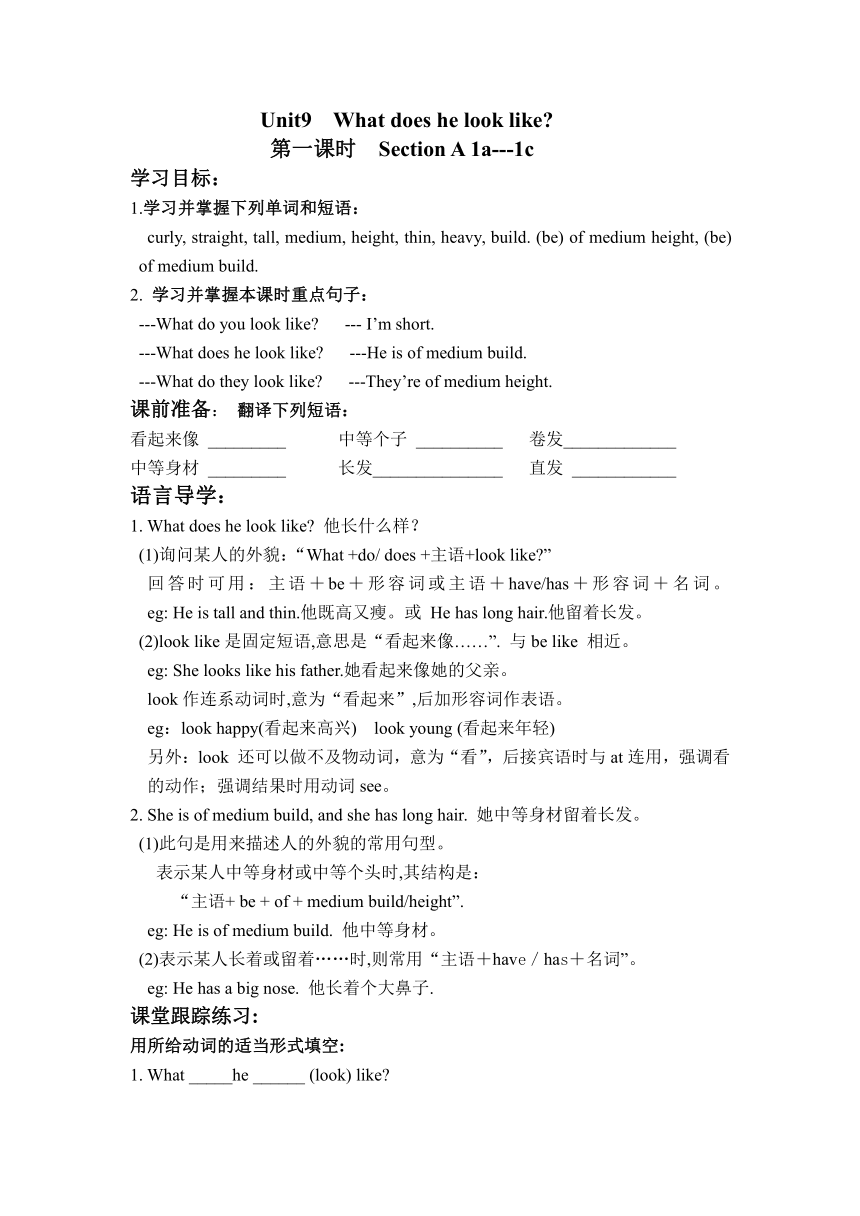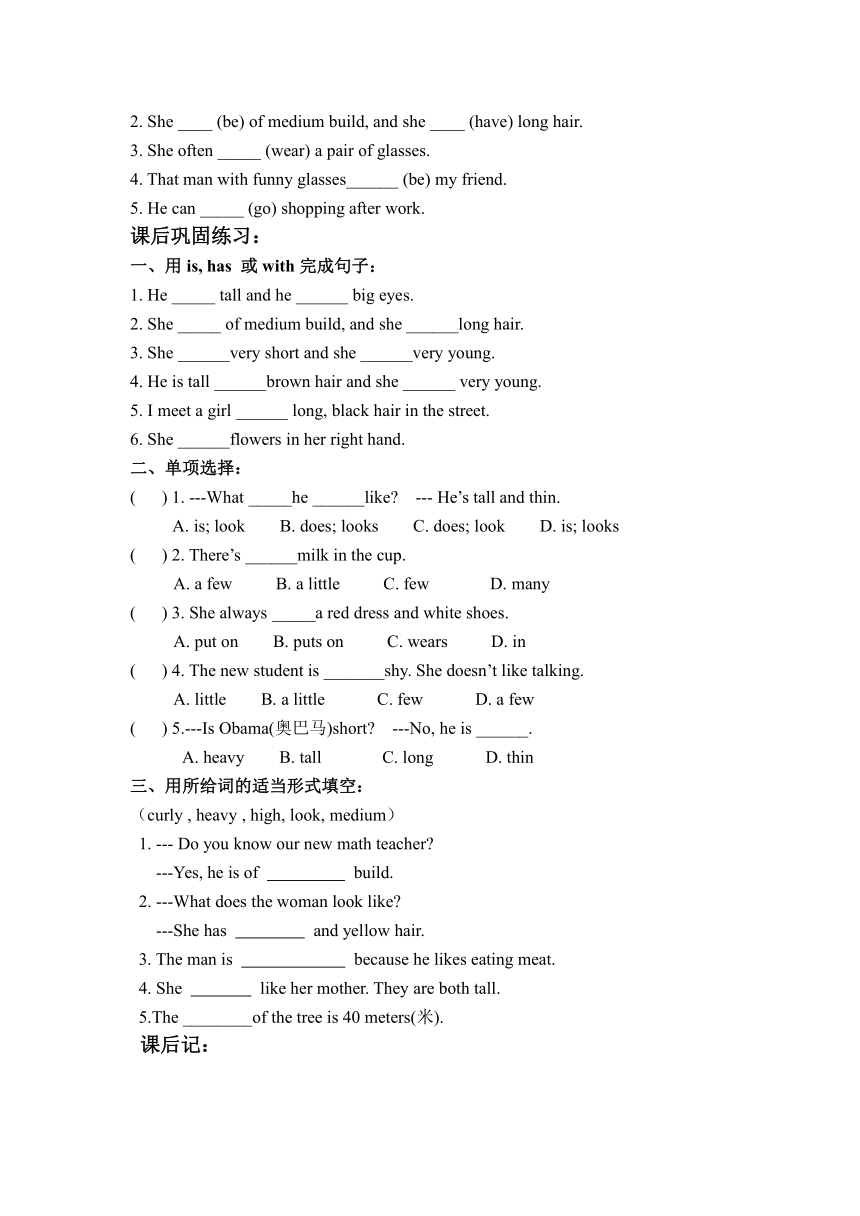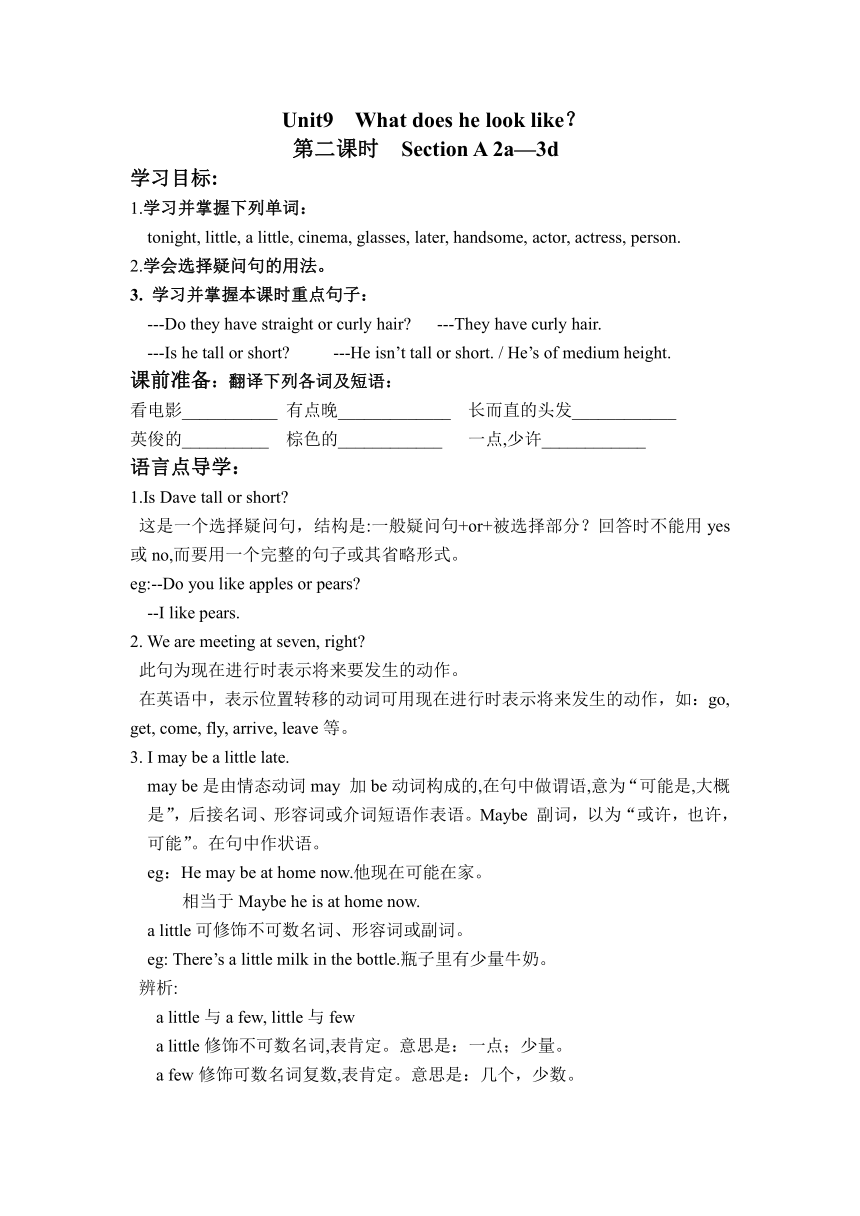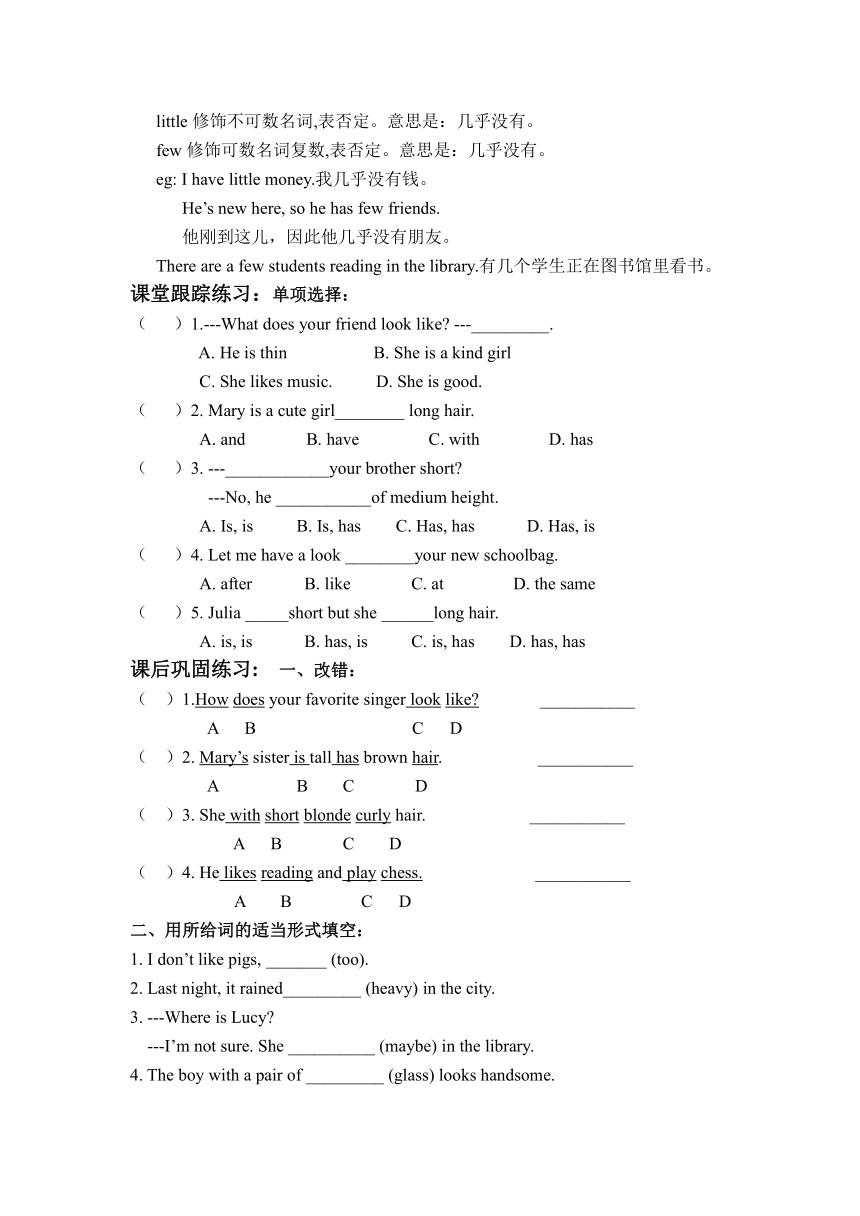Unit 9 What does he look like?学案
文档属性
| 名称 | Unit 9 What does he look like?学案 |

|
|
| 格式 | zip | ||
| 文件大小 | 14.8KB | ||
| 资源类型 | 教案 | ||
| 版本资源 | 人教新目标(Go for it)版 | ||
| 科目 | 英语 | ||
| 更新时间 | 2015-03-25 16:33:16 | ||
图片预览




文档简介
Unit9 What does he look like
第一课时 Section A 1a---1c
学习目标:
1.学习并掌握下列单词和短语:
curly, straight, tall, medium, height, thin, heavy, build. (be) of medium height, (be) of medium build.
2. 学习并掌握本课时重点句子:
---What do you look like --- I’m short.
---What does he look like ---He is of medium build.
---What do they look like ---They’re of medium height.
课前准备: 翻译下列短语:
看起来像 _________ 中等个子 __________ 卷发_____________
中等身材 _________ 长发_______________ 直发 ____________
语言导学:
1. What does he look like 他长什么样?
(1)询问某人的外貌:“What +do/ does +主语+look like ”
回答时可用:主语+be+形容词或主语+have/has+形容词+名词。 eg: He is tall and thin.他既高又瘦。或 He has long hair.他留着长发。
(2)look like是固定短语,意思是“看起来像……”. 与be like 相近。
eg: She looks like his father.她看起来像她的父亲。
look作连系动词时,意为“看起来”,后加形容词作表语。
eg:look happy(看起来高兴) look young (看起来年轻)
另外:look 还可以做不及物动词,意为“看”,后接宾语时与at连用,强调看的动作;强调结果时用动词see。
2. She is of medium build, and she has long hair. 她中等身材留着长发。
(1)此句是用来描述人的外貌的常用句型。
表示某人中等身材或中等个头时,其结构是:
“主语+ be + of + medium build/height”.
eg: He is of medium build. 他中等身材。
(2)表示某人长着或留着……时,则常用“主语+have/has+名词”。
eg: He has a big nose. 他长着个大鼻子.
课堂跟踪练习:
用所给动词的适当形式填空:
1. What _____he ______ (look) like
2. She ____ (be) of medium build, and she ____ (have) long hair.
3. She often _____ (wear) a pair of glasses.
4. That man with funny glasses______ (be) my friend.
5. He can _____ (go) shopping after work.
课后巩固练习:
一、用is, has 或with完成句子:
1. He _____ tall and he ______ big eyes.
2. She _____ of medium build, and she ______long hair.
3. She ______very short and she ______very young.
4. He is tall ______brown hair and she ______ very young.
5. I meet a girl ______ long, black hair in the street.
6. She ______flowers in her right hand.
二、单项选择:
( ) 1. ---What _____he ______like --- He’s tall and thin.
A. is; look B. does; looks C. does; look D. is; looks
( ) 2. There’s ______milk in the cup.
A. a few B. a little C. few D. many
( ) 3. She always _____a red dress and white shoes.
A. put on B. puts on C. wears D. in
( ) 4. The new student is _______shy. She doesn’t like talking.
A. little B. a little C. few D. a few
( ) 5.---Is Obama(奥巴马)short ---No, he is ______.
A. heavy B. tall C. long D. thin
三、用所给词的适当形式填空:
(curly , heavy , high, look, medium)
1. --- Do you know our new math teacher
---Yes, he is of build.
2. ---What does the woman look like
---She has and yellow hair.
3. The man is because he likes eating meat.
4. She like her mother. They are both tall.
5.The ________of the tree is 40 meters(米).
课后记:
Unit9 What does he look like?
第二课时 Section A 2a—3d
学习目标:
1.学习并掌握下列单词:
tonight, little, a little, cinema, glasses, later, handsome, actor, actress, person.
2.学会选择疑问句的用法。
3. 学习并掌握本课时重点句子:
---Do they have straight or curly hair ---They have curly hair.
---Is he tall or short ---He isn’t tall or short. / He’s of medium height.
课前准备:翻译下列各词及短语:
看电影___________ 有点晚_____________ 长而直的头发____________
英俊的__________ 棕色的____________ 一点,少许____________
语言点导学:
1.Is Dave tall or short
这是一个选择疑问句,结构是:一般疑问句+or+被选择部分?回答时不能用yes或no,而要用一个完整的句子或其省略形式。
eg:--Do you like apples or pears
--I like pears.
2. We are meeting at seven, right
此句为现在进行时表示将来要发生的动作。
在英语中,表示位置转移的动词可用现在进行时表示将来发生的动作,如:go, get, come, fly, arrive, leave等。
3. I may be a little late.
may be是由情态动词may 加be动词构成的,在句中做谓语,意为“可能是,大概是”,后接名词、形容词或介词短语作表语。Maybe 副词,以为“或许,也许,可能”。在句中作状语。
eg:He may be at home now.他现在可能在家。
相当于Maybe he is at home now.
a little可修饰不可数名词、形容词或副词。
eg: There’s a little milk in the bottle.瓶子里有少量牛奶。
辨析:
a little与a few, little与few
a little修饰不可数名词,表肯定。意思是:一点;少量。
a few修饰可数名词复数,表肯定。意思是:几个,少数。
little修饰不可数名词,表否定。意思是:几乎没有。
few修饰可数名词复数,表否定。意思是:几乎没有。
eg: I have little money.我几乎没有钱。
He’s new here, so he has few friends.
他刚到这儿,因此他几乎没有朋友。
There are a few students reading in the library.有几个学生正在图书馆里看书。
课堂跟踪练习:单项选择:
( )1.---What does your friend look like ---_________.
A. He is thin B. She is a kind girl
C. She likes music. D. She is good.
( )2. Mary is a cute girl________ long hair.
A. and B. have C. with D. has
( )3. ---____________your brother short
---No, he ___________of medium height.
A. Is, is B. Is, has C. Has, has D. Has, is
( )4. Let me have a look ________your new schoolbag.
A. after B. like C. at D. the same
( )5. Julia _____short but she ______long hair.
A. is, is B. has, is C. is, has D. has, has
课后巩固练习: 一、改错:
( )1.How does your favorite singer look like ___________
A B C D
( )2. Mary’s sister is tall has brown hair. ___________
A B C D
( )3. She with short blonde curly hair. ___________
A B C D
( )4. He likes reading and play chess. ___________
A B C D
二、用所给词的适当形式填空:
1. I don’t like pigs, _______ (too).
2. Last night, it rained_________ (heavy) in the city.
3. ---Where is Lucy
---I’m not sure. She __________ (maybe) in the library.
4. The boy with a pair of _________ (glass) looks handsome.
5. ---Can you come to my party tonight
---Sure, see you ________ (late).
6. My father isn’t thin or heavy. He’s of medium________(building).
课后记:
Unit9 What does he look like
第三课时 Section B 1a---1e
学习目标:
1.学习并掌握下列单词:nose, blonde, mouth, round, face, eye, singer.
2. 学习并掌握本课时重点句子:---What do/does…look like
---…wear/wears glasses.
课前准备:翻译下列短语:
1.带着眼镜____________ 2. 留着黄头发________________
3. 大眼睛 ____________ 4.一个大鼻子_________________
5. 一个小嘴____________ 6. 长着一张长脸______________
7.短直发 ____________ 8.一张圆脸___________________
语言点导学:
1. He wears glasses. 他戴眼镜。
glasses 是名词“眼镜”,表示复数概念,无单数形式,当表示“一副眼镜”
时,应用a pair of glasses.
拓展:glass (1) n. “玻璃”,不可数名词。
eg: Be careful of glass. 小心玻璃。
(2)n. “玻璃杯”,是可数名词,复数形式为glasses.
eg: There are some glasses on the table.桌子上有些玻璃杯。
2. He has short curly brown hair. 他有一头短而卷曲的棕色头发。
注意:形容词排列:长短,大小,形状,颜色。
课堂跟踪练习:单项选择:
( ) 1. Could you tell me _______
A. what is your job B. what your job is
C. your job is what D. how you job is
( ) 2. Tell the children _______ on the street. It’s dangerous(危险的).
A. not to play B. not play C. to play D. playing
( ) 3. --- Would you like to have _______ apple
--- No, thanks. I’m full. (饱的)
A. more B. another C. other D. the other
( ) 4. --- _______ does he look like --- He’s tall and thin.
A. What B. Why C. Who D. How
( ) 5. The boy is _______thin but he is healthy.
A. little B. bit C. little bit D. a little
( ) 6. The teacher comes in. We must stop_______.
A. talk B. talking C. to talk D. talks
( ) 7.His mother loves_________.
A. go shopping B. to go shopping C. to go shop D. go shop
课后巩固练习:一、根据所给汉语意思完成句子:
1.我不认识那位戴眼镜的歌手。
I don’t know the singer .
2.她喜欢讲故事。She loves to .
3.她的头发又黑又长。Her hair and .
4.那个女孩长着一张圆脸,两只大大的眼睛。
The girl a round face, two eyes.
5.玛丽的个头适中,长相好看。
Mary is and .
6.成龙留着短头发。Jack Chan .
二、阅读理解:
There is a shy girl in our class. She is twelve years old. She is not tall and she is not short. She is a little fat. Her face is round, like an apple. She has two big black eyes and a small nose. Her mouth is big. But her ears are small. Her hair is short and black. She likes red. But today she is wearing a yellow sweater, blue jeans and white shoes. She dislikes(不喜欢) getting up early so she is usually late for school. She doesn’t like to talk to others. She likes little animals. She has a little black dog. She and the dog are good friends.
( ) 1. The girl is .
A. tall B. of medium build C. short D. of medium height
( ) 2. She likes the color .
A. blue B. yellow C. red D. white
( ) 3. She like getting up early.
A. isn’t B. doesn’t C. don’t D. aren’t
( ) 4. The girl usually .
A. goes to school B. likes going to school late
C. talks to others D. gets up early for school
( ) 5. She likes animals.
A. a bit B. a little C. little D. a few
课后记:
Unit9 What does he look like
第四课时 Section B 2a---self check
学习目标:
1.学习并掌握下列单词: artist, crime, criminal, put, each, way, describe, differently, another, end, in the end, real, jeans.
2. 学习并掌握本课时重点句子:---What does he look like
---He is tall and thin.
课前准备:试着翻译下列句子。
1.你的新朋友长什么样?____________________________________?
2.她留着长发。______________________________________________。
3.我高而瘦。________________________________________________。
4.她戴眼镜,中等身材。______________________________________。
5.玛丽身材苗条,中等个子。__________________________________。
语言点导学:
1.He wants to draw a good picture of each criminal, but this job is sometimes difficult.他想把每一个罪犯的图片画得很好,但是这份工作有时很困难。
(1)each,形容词,后面只能接单数可数名词。
eg: Each student in the classroom gets an apple.
教室里每个学生都得到一个苹果。
(2)each可作代词,意为“每个,各个”。可单独做主语,也可后接“of+复数名词/代词”做主语,其谓语动词用单数形式。若用作同位语时,须放在主语的后面,谓语动词用复数。
Every形容词,用作定语,用于三者或三者以上,强调整体。
eg: Each of them has a new book.他们每人有一本新书。
Each of the students has a new bike.每个学生都有一辆新自行车。
They each want to get the ball.他们每个人都想得到球。
Every student has a new bike.
2.…says one woman. Another woman says,…
……一个妇女说。另一个妇女说,……
another 在此处是限定词,也可作代词,泛指同类事物中三者或三者以上的“另一个”,只能代替或修饰单数可数名词。
eg: I don’t like this one. Please show me another.
我不喜欢这一个。请给我看一下另一个。
拓展:another“又,再”。后接“数量+单数可数名词/复数名词”=数量+more+单数可数名词/复数名词
eg:He takes another two apples = He takes two more apples.
3.first of all 为固定搭配,意为“首先”,强调次序,后常接next, then等,通常位于句首。
eg: First of all, let me introduce myself to you. 首先,让我自我介绍一下。
4.be good at 意为“擅长;在…….方面做得好”,相当于do well in. 后接名词,代词或动名词。
eg: I’m good at English. =I do well in English.我擅长英语。
Mary is good at playing tennis. = Mary does well in playing tennis.
玛丽擅长打网球。
课堂跟踪练习:用所给词的适当形式填空:
1. Mr Smith always wears . (glass)
2. He is of medium . (high)
3. I want to go (shop) with my mother.
4. Jay Chou is good at . (sing)
5. Listen! He (sing) in the next room.
6. She (not have) long hair.
7. There (be) some water in the glass.
8. Can you describe the (crime) clearly What does he look like
9. The story isn’t (really). It’s only a legend(传说).
10. Is there anything (interest) in today’s newspaper
课后巩固练习:书面表达:
假如你是Ann, Gina 是你的朋友,你们两个在相貌上有很大的不同。请根据下面表中的信息,描述一下你和你同桌的外貌特征,60个词左右。
Name The color of eyes Hair Build
Ann blue black, long, straight short and heavy
Gina brown yellow, short and curly tall and thin
_____________________________________________________________________________________________________________________________________________________________________________________________________________________________________________________________________________________________________________________________________________________________________________________________________________________________.
课后记:
第一课时 Section A 1a---1c
学习目标:
1.学习并掌握下列单词和短语:
curly, straight, tall, medium, height, thin, heavy, build. (be) of medium height, (be) of medium build.
2. 学习并掌握本课时重点句子:
---What do you look like --- I’m short.
---What does he look like ---He is of medium build.
---What do they look like ---They’re of medium height.
课前准备: 翻译下列短语:
看起来像 _________ 中等个子 __________ 卷发_____________
中等身材 _________ 长发_______________ 直发 ____________
语言导学:
1. What does he look like 他长什么样?
(1)询问某人的外貌:“What +do/ does +主语+look like ”
回答时可用:主语+be+形容词或主语+have/has+形容词+名词。 eg: He is tall and thin.他既高又瘦。或 He has long hair.他留着长发。
(2)look like是固定短语,意思是“看起来像……”. 与be like 相近。
eg: She looks like his father.她看起来像她的父亲。
look作连系动词时,意为“看起来”,后加形容词作表语。
eg:look happy(看起来高兴) look young (看起来年轻)
另外:look 还可以做不及物动词,意为“看”,后接宾语时与at连用,强调看的动作;强调结果时用动词see。
2. She is of medium build, and she has long hair. 她中等身材留着长发。
(1)此句是用来描述人的外貌的常用句型。
表示某人中等身材或中等个头时,其结构是:
“主语+ be + of + medium build/height”.
eg: He is of medium build. 他中等身材。
(2)表示某人长着或留着……时,则常用“主语+have/has+名词”。
eg: He has a big nose. 他长着个大鼻子.
课堂跟踪练习:
用所给动词的适当形式填空:
1. What _____he ______ (look) like
2. She ____ (be) of medium build, and she ____ (have) long hair.
3. She often _____ (wear) a pair of glasses.
4. That man with funny glasses______ (be) my friend.
5. He can _____ (go) shopping after work.
课后巩固练习:
一、用is, has 或with完成句子:
1. He _____ tall and he ______ big eyes.
2. She _____ of medium build, and she ______long hair.
3. She ______very short and she ______very young.
4. He is tall ______brown hair and she ______ very young.
5. I meet a girl ______ long, black hair in the street.
6. She ______flowers in her right hand.
二、单项选择:
( ) 1. ---What _____he ______like --- He’s tall and thin.
A. is; look B. does; looks C. does; look D. is; looks
( ) 2. There’s ______milk in the cup.
A. a few B. a little C. few D. many
( ) 3. She always _____a red dress and white shoes.
A. put on B. puts on C. wears D. in
( ) 4. The new student is _______shy. She doesn’t like talking.
A. little B. a little C. few D. a few
( ) 5.---Is Obama(奥巴马)short ---No, he is ______.
A. heavy B. tall C. long D. thin
三、用所给词的适当形式填空:
(curly , heavy , high, look, medium)
1. --- Do you know our new math teacher
---Yes, he is of build.
2. ---What does the woman look like
---She has and yellow hair.
3. The man is because he likes eating meat.
4. She like her mother. They are both tall.
5.The ________of the tree is 40 meters(米).
课后记:
Unit9 What does he look like?
第二课时 Section A 2a—3d
学习目标:
1.学习并掌握下列单词:
tonight, little, a little, cinema, glasses, later, handsome, actor, actress, person.
2.学会选择疑问句的用法。
3. 学习并掌握本课时重点句子:
---Do they have straight or curly hair ---They have curly hair.
---Is he tall or short ---He isn’t tall or short. / He’s of medium height.
课前准备:翻译下列各词及短语:
看电影___________ 有点晚_____________ 长而直的头发____________
英俊的__________ 棕色的____________ 一点,少许____________
语言点导学:
1.Is Dave tall or short
这是一个选择疑问句,结构是:一般疑问句+or+被选择部分?回答时不能用yes或no,而要用一个完整的句子或其省略形式。
eg:--Do you like apples or pears
--I like pears.
2. We are meeting at seven, right
此句为现在进行时表示将来要发生的动作。
在英语中,表示位置转移的动词可用现在进行时表示将来发生的动作,如:go, get, come, fly, arrive, leave等。
3. I may be a little late.
may be是由情态动词may 加be动词构成的,在句中做谓语,意为“可能是,大概是”,后接名词、形容词或介词短语作表语。Maybe 副词,以为“或许,也许,可能”。在句中作状语。
eg:He may be at home now.他现在可能在家。
相当于Maybe he is at home now.
a little可修饰不可数名词、形容词或副词。
eg: There’s a little milk in the bottle.瓶子里有少量牛奶。
辨析:
a little与a few, little与few
a little修饰不可数名词,表肯定。意思是:一点;少量。
a few修饰可数名词复数,表肯定。意思是:几个,少数。
little修饰不可数名词,表否定。意思是:几乎没有。
few修饰可数名词复数,表否定。意思是:几乎没有。
eg: I have little money.我几乎没有钱。
He’s new here, so he has few friends.
他刚到这儿,因此他几乎没有朋友。
There are a few students reading in the library.有几个学生正在图书馆里看书。
课堂跟踪练习:单项选择:
( )1.---What does your friend look like ---_________.
A. He is thin B. She is a kind girl
C. She likes music. D. She is good.
( )2. Mary is a cute girl________ long hair.
A. and B. have C. with D. has
( )3. ---____________your brother short
---No, he ___________of medium height.
A. Is, is B. Is, has C. Has, has D. Has, is
( )4. Let me have a look ________your new schoolbag.
A. after B. like C. at D. the same
( )5. Julia _____short but she ______long hair.
A. is, is B. has, is C. is, has D. has, has
课后巩固练习: 一、改错:
( )1.How does your favorite singer look like ___________
A B C D
( )2. Mary’s sister is tall has brown hair. ___________
A B C D
( )3. She with short blonde curly hair. ___________
A B C D
( )4. He likes reading and play chess. ___________
A B C D
二、用所给词的适当形式填空:
1. I don’t like pigs, _______ (too).
2. Last night, it rained_________ (heavy) in the city.
3. ---Where is Lucy
---I’m not sure. She __________ (maybe) in the library.
4. The boy with a pair of _________ (glass) looks handsome.
5. ---Can you come to my party tonight
---Sure, see you ________ (late).
6. My father isn’t thin or heavy. He’s of medium________(building).
课后记:
Unit9 What does he look like
第三课时 Section B 1a---1e
学习目标:
1.学习并掌握下列单词:nose, blonde, mouth, round, face, eye, singer.
2. 学习并掌握本课时重点句子:---What do/does…look like
---…wear/wears glasses.
课前准备:翻译下列短语:
1.带着眼镜____________ 2. 留着黄头发________________
3. 大眼睛 ____________ 4.一个大鼻子_________________
5. 一个小嘴____________ 6. 长着一张长脸______________
7.短直发 ____________ 8.一张圆脸___________________
语言点导学:
1. He wears glasses. 他戴眼镜。
glasses 是名词“眼镜”,表示复数概念,无单数形式,当表示“一副眼镜”
时,应用a pair of glasses.
拓展:glass (1) n. “玻璃”,不可数名词。
eg: Be careful of glass. 小心玻璃。
(2)n. “玻璃杯”,是可数名词,复数形式为glasses.
eg: There are some glasses on the table.桌子上有些玻璃杯。
2. He has short curly brown hair. 他有一头短而卷曲的棕色头发。
注意:形容词排列:长短,大小,形状,颜色。
课堂跟踪练习:单项选择:
( ) 1. Could you tell me _______
A. what is your job B. what your job is
C. your job is what D. how you job is
( ) 2. Tell the children _______ on the street. It’s dangerous(危险的).
A. not to play B. not play C. to play D. playing
( ) 3. --- Would you like to have _______ apple
--- No, thanks. I’m full. (饱的)
A. more B. another C. other D. the other
( ) 4. --- _______ does he look like --- He’s tall and thin.
A. What B. Why C. Who D. How
( ) 5. The boy is _______thin but he is healthy.
A. little B. bit C. little bit D. a little
( ) 6. The teacher comes in. We must stop_______.
A. talk B. talking C. to talk D. talks
( ) 7.His mother loves_________.
A. go shopping B. to go shopping C. to go shop D. go shop
课后巩固练习:一、根据所给汉语意思完成句子:
1.我不认识那位戴眼镜的歌手。
I don’t know the singer .
2.她喜欢讲故事。She loves to .
3.她的头发又黑又长。Her hair and .
4.那个女孩长着一张圆脸,两只大大的眼睛。
The girl a round face, two eyes.
5.玛丽的个头适中,长相好看。
Mary is and .
6.成龙留着短头发。Jack Chan .
二、阅读理解:
There is a shy girl in our class. She is twelve years old. She is not tall and she is not short. She is a little fat. Her face is round, like an apple. She has two big black eyes and a small nose. Her mouth is big. But her ears are small. Her hair is short and black. She likes red. But today she is wearing a yellow sweater, blue jeans and white shoes. She dislikes(不喜欢) getting up early so she is usually late for school. She doesn’t like to talk to others. She likes little animals. She has a little black dog. She and the dog are good friends.
( ) 1. The girl is .
A. tall B. of medium build C. short D. of medium height
( ) 2. She likes the color .
A. blue B. yellow C. red D. white
( ) 3. She like getting up early.
A. isn’t B. doesn’t C. don’t D. aren’t
( ) 4. The girl usually .
A. goes to school B. likes going to school late
C. talks to others D. gets up early for school
( ) 5. She likes animals.
A. a bit B. a little C. little D. a few
课后记:
Unit9 What does he look like
第四课时 Section B 2a---self check
学习目标:
1.学习并掌握下列单词: artist, crime, criminal, put, each, way, describe, differently, another, end, in the end, real, jeans.
2. 学习并掌握本课时重点句子:---What does he look like
---He is tall and thin.
课前准备:试着翻译下列句子。
1.你的新朋友长什么样?____________________________________?
2.她留着长发。______________________________________________。
3.我高而瘦。________________________________________________。
4.她戴眼镜,中等身材。______________________________________。
5.玛丽身材苗条,中等个子。__________________________________。
语言点导学:
1.He wants to draw a good picture of each criminal, but this job is sometimes difficult.他想把每一个罪犯的图片画得很好,但是这份工作有时很困难。
(1)each,形容词,后面只能接单数可数名词。
eg: Each student in the classroom gets an apple.
教室里每个学生都得到一个苹果。
(2)each可作代词,意为“每个,各个”。可单独做主语,也可后接“of+复数名词/代词”做主语,其谓语动词用单数形式。若用作同位语时,须放在主语的后面,谓语动词用复数。
Every形容词,用作定语,用于三者或三者以上,强调整体。
eg: Each of them has a new book.他们每人有一本新书。
Each of the students has a new bike.每个学生都有一辆新自行车。
They each want to get the ball.他们每个人都想得到球。
Every student has a new bike.
2.…says one woman. Another woman says,…
……一个妇女说。另一个妇女说,……
another 在此处是限定词,也可作代词,泛指同类事物中三者或三者以上的“另一个”,只能代替或修饰单数可数名词。
eg: I don’t like this one. Please show me another.
我不喜欢这一个。请给我看一下另一个。
拓展:another“又,再”。后接“数量+单数可数名词/复数名词”=数量+more+单数可数名词/复数名词
eg:He takes another two apples = He takes two more apples.
3.first of all 为固定搭配,意为“首先”,强调次序,后常接next, then等,通常位于句首。
eg: First of all, let me introduce myself to you. 首先,让我自我介绍一下。
4.be good at 意为“擅长;在…….方面做得好”,相当于do well in. 后接名词,代词或动名词。
eg: I’m good at English. =I do well in English.我擅长英语。
Mary is good at playing tennis. = Mary does well in playing tennis.
玛丽擅长打网球。
课堂跟踪练习:用所给词的适当形式填空:
1. Mr Smith always wears . (glass)
2. He is of medium . (high)
3. I want to go (shop) with my mother.
4. Jay Chou is good at . (sing)
5. Listen! He (sing) in the next room.
6. She (not have) long hair.
7. There (be) some water in the glass.
8. Can you describe the (crime) clearly What does he look like
9. The story isn’t (really). It’s only a legend(传说).
10. Is there anything (interest) in today’s newspaper
课后巩固练习:书面表达:
假如你是Ann, Gina 是你的朋友,你们两个在相貌上有很大的不同。请根据下面表中的信息,描述一下你和你同桌的外貌特征,60个词左右。
Name The color of eyes Hair Build
Ann blue black, long, straight short and heavy
Gina brown yellow, short and curly tall and thin
_____________________________________________________________________________________________________________________________________________________________________________________________________________________________________________________________________________________________________________________________________________________________________________________________________________________________.
课后记:
同课章节目录
- Unit 1 Can you play the guitar?
- Section A
- Section B
- Unit 2 What time do you go to school?
- Section A
- Section B
- Unit 3 How do you get to school?
- Section A
- Section B
- Unit 4 Don't eat in class.
- Section A
- Section B
- Unit 5 Why do you like pandas?
- Section A
- Section B
- Unit 6 I'm watching TV.
- Section A
- Section B
- Review of Units 1-6
- Unit 7 It's raining!
- Section A
- Section B
- Unit 8 Is there a post office near here?
- Section A
- Section B
- Unit 9 What does he look like?
- Section A
- Section B
- Unit 10 I'd like some noodles.
- Section A
- Section B
- Unit 11 How was your school trip?
- Section A
- Section B
- Unit 12 What did you do last weekend?
- Section A
- Section B
